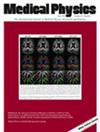On the origin of MTF reduction in grating-based x-ray differential phase contrast CT imaging
Abstract
Background
The complementary absorption contrast CT (ACT) and differential phase contrast CT (DPCT) can be generated simultaneously from an x-ray computed tomography (CT) imaging system incorporated with grating interferometer. However, it has been reported that ACT images exhibit better spatial resolution than DPCT images. By far, the primary cause of such discrepancy remains unclear.
Purpose
The purpose of this study is to investigate the underlying cause of the resolution discrepancy between ACT and DPCT in a grating interferometer CT imaging system.
Methods
In this study, theoretical derivations were performed with a -phase Talbot–Lau grating interferometer system to model the signal formation mechanism of absorption imaging and phase imaging, respectively. In addition, physical, and numerical experiments were conducted to verify the theoretical findings and assess the resolution discrepancy between ACT and DPCT under various conditions. Herein, the ACT and DPCT images were reconstructed from the filtered-back-projection algorithm using a standard Ramp filter and a standard Hilbert filter, respectively.
Results
Experiments demonstrated that the spatial resolution of ACT and DPCT images are primarily impacted by the beam diffraction induced signal splitting. In particular, lower modulation transfer function (MTF) was observed for DPCT than ACT due to the opposite-superposition of phase signals. In addition, factors such as focal spot size, beam spectra, object composition, sample size, and detector pixel size were found to have minor impacts on the MTFs of both ACT and DPCT.
Conclusions
In conclusion, this study reveals that the opposite-superposition of split phase signals causes the spatial resolution reduction in DPCT imaging.

 求助内容:
求助内容: 应助结果提醒方式:
应助结果提醒方式:


